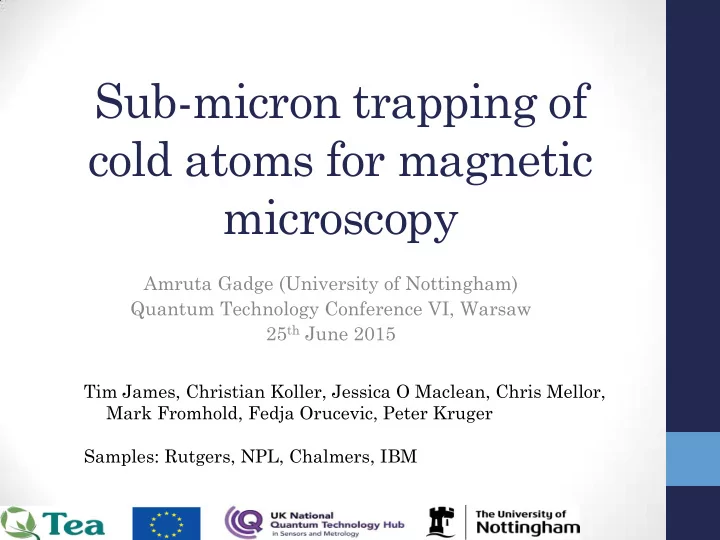

Sub-micron trapping of cold atoms for magnetic microscopy Amruta Gadge (University of Nottingham) Quantum Technology Conference VI, Warsaw 25 th June 2015 Tim James, Christian Koller, Jessica O Maclean, Chris Mellor, Mark Fromhold, Fedja Orucevic, Peter Kruger Samples: Rutgers, NPL, Chalmers, IBM
Quantum sensors • Exploiting quantum effects for precision measurements • Cold atoms are ideal candidates for sensing applications.
Outline Ultra-close trapping of atoms • Motivation • Atom-surface interactions • Possibility of sub-micron trapping • Ideal samples The experiment • Experimental set up • Dual colour MOT • Magnetic transport of atoms
Chip based magnetic field sensor • Trapped cold atoms are extremely sensitive to magnetic field landscape. They are ideal as magnetic field sensors. • Local magnetic fields can be deduced from the density distribution of the trapped atoms. Wildermuth et al. NATURE|Vol 435|26 May 2005
Submicron trapping of the atoms • Limitation on trapping separations~ 10-100µm. • Atom cloud positioned very close to the surface, will be a sensor with high sensitivity, high resolution and with large field of view What are the limitations? • Distance dependent atom- surface interactions become dominant. • Casimir force, Johnson noise, stray potentials from adsorbates, wire corrugations, technical noise • Modification of trapping potential due to surface forces leading to losses • Reduction of life time
Thermal magnetic near field noise • Thermal of motion of electrons in a conductor causes current fluctuations- Johnson Nyquist Noise • Current fluctuations lead to magnetic field fluctuations • These fluctuations couple to atomic spin inducing transition to anti trapped state. k T 0 B S ( ) s g ( d , h , ) B d 16
Minimizing thermal noise • . For thin wire of finite width ( ( h , d )) h w g . h d w d 2 • For d<<h, h 1 (Bulk behavior) d ( h d ) d h h • For d>>h, For d=1 μ m, h= 100nm 2 0 d ( h d ) d . 1 0 Ten times increase in lifetime! 2 2 K B T h w 9 0 B . s 640 d h d w 2 d
Casimir Polder interaction • Attractive interaction between neutral atom and the surface. • Strongly distance dependent 2 C m j 2 0 U ( z ) U total z j 2 ( z ) Nathan Welsh (2015)
Effects of surface interaction • Modification of trapping potential • Reduction of trap depth • Modification of trap frequency • Shift in trap position Interaction depends on material properties c 3 1 0 r C ( ) 4 r 2 32 1 0 r This interaction is weaker between atom and a thin dielectric surface.
Stray potential due to adsorbates • Atoms adsorbed on the surface get polarized and generate electric field perpendicular to the surface. • Combined field due to adsorbed atoms can be significant. • Potential generated can be given as, 2 0 V a E r ( ) 2
Is submicron trapping possible? Yes if the surface is carefully chosen! Ideal sample • Very thin thin membranes (silicon nitride membranes) • Dielectric Silicon nitride membranes • Possibility of in-situ cleaning
Silicon Nitride membranes • Thin silicon nitride membranes of thickness 10 and 100nm supported on a silicon frame. • Each sample has 9 membrane windows. • Different patterns are made on each of these membrane windows. • Patterning is done by milling away material using focused ion beam technique. Ion beam E-beam Transport PCB Samples from Norcada Inc, Canada FIB patterning: Dr Leo Gross, IBM, Zurich Sample holder
Some patterns on 100nm membranes
Silicon Nitride 10nm membrane 100nm membrane
Our experiment Magneto optical trap for Rubidium 87 atoms • Initial trap Macroscopic magnetic trap • Transport chip • (fabricated using printed circuit board technology) Atomic manipulation Atom chip • Location of various samples Experiment
Our experiment Samples Atom chip Transport chip Reflection QWP
5 beam MOT Imaging Beam2 Beam1 Beam3 Beam4 Beam5
Two colour scheme Increased atom number in MOT by using slightly detuned two frequencies • |e> 𝛽 𝜕 𝑓 − 𝜀 𝛽 Single color MOT 𝜕 2 𝜕 𝑓 𝜕 1 𝜕 𝑚 |g> Cao Qiang et. al. Chin. Phys. B Vol. 21, No. 4 (2012)
Chip based atom traps By turning these wires either in • U or Z shape, confinement in Z-currnet: Single wire: third direction can be obtained. Ioffe-Pritchard trap Side guide R Folman, P Kruger , J Schmiedmayer , J Denschlag, C Henkel(2002)
Transport of atoms • Four wire guide for tight confinement of atoms in two directions. • Set of orthogonal wires for weak confinement in third direction. • By modulating currents in these transport wires, trap position can be shifted from one wire to next. I1 Transport wires I1 I2 I2 Long et.al Eur. Phys. J. D 35, 125 – 133 (2005)
Transport PCB Our design 10 layer printed circuit board • Top layer contains transport wires, vias and contact pads for atom chip. • Bottom layers contain quadrupole wires. •
I1 I2 I3 I4 I5 I6
Atom chip • Two layer atom chip to manipulate and precisely position atoms very close to the surface. • Grid of wires of widths 30µm and 100µm on top and bottom layers respectively.
Summary Samples Atom chip Transport chip Reflection QWP
Summary • At separations below a micron various surface forces impede separation of trapped atoms • Ultra-close atom trapping is possible with use of thin membranes. • We are in process of developing a system to trap atoms very close surfaces. • Magnetic field microscopy with much better resolution can be performed with such a system.
Thank you!
Recommend
More recommend